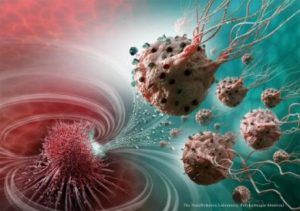Aug 16 2016
Delivering Chemotherapy with Nanocarriers
 One of the great promises of nanotechnology is that we will be able to send swarms of these microscopic robots into your body to do all sorts of helpful things, like clean plaque from your arteries, repair cell damage, and kill cancer cells. Theoretically, these are all great ideas. There are, however, non-trivial technological hurdles to realizing the potential of this technology.
One of the great promises of nanotechnology is that we will be able to send swarms of these microscopic robots into your body to do all sorts of helpful things, like clean plaque from your arteries, repair cell damage, and kill cancer cells. Theoretically, these are all great ideas. There are, however, non-trivial technological hurdles to realizing the potential of this technology.
Another related great idea is the concept of delivering chemotherapy directly to cancer cells with some sort of targeted nanocarrier. Chemotherapy for cancer primarily refers to toxic drugs that kill cells. Specific drugs are given in specific doses so that they primarily kill rapidly dividing cells, which include cancer cells, but have less of a toxic effect on cells with a more typical rate of division. Still, chemotherapy makes people very sick and we are generally pushing this toxicity to its limits in order to maximize the effect against cancer cells.
What if, however, we could deliver the chemotherapy directly to cancer cells? In fact, anything we can do to increase the concentration of chemotherapy in the cancer and reduce the concentration outside of the cancer will enhance efficacy and reduce side effects.
We use similar logic when delivering radiation therapy, which also is more lethal to rapidly dividing cells. For example, radiation therapists will focus a beam of radiation from many angles, all intersecting at the tumor, so the total dose of radiation to the tumor is high, while the total dose to other tissue is low.
We may have pushed forward nanocarrier technology one step with a new and very interesting study. The headline of the news report reads: Legions of nanorobots target cancerous tumors with precision.
This a bit misleading. The title of the actual paper reads: Magneto-aerotactic bacteria deliver drug-containing nanoliposomes to tumour hypoxic regions. The “nanorobots” are actually bacteria. The term “precision” is also used very loosely here.
The hyped headline aside, the actual research is quite interesting. The researchers used Magnetococcus marinus bacteria (MC-1 strain), which are flagellated, so that they can move on their own, and also have two sensing systems that guide their movements. They move along magnetic force lines, and they also move toward areas of low oxygen (they move down an oxygen gradient).
The researchers injected MC-1 cells near a tumor in mice. They then used an external computer-guided magnetic field to guide the bacteria to the tumor. The bacteria also naturally swim to hypoxic areas (low oxygen areas). This further moved the bacteria to the area of interest.
Because aggressive cancers use up a lot of metabolic resources, including oxygen, they typically have hypoxic regions that are getting too little blood flow to maintain optimal oxygen concentrations. They also contain necrotic areas where the oxygen levels are so low the cancer cells die, but the hypoxic regions have living cancer cells with low oxygen.
Hypoxic regions present a challenge because the lack of blood flow means they are hard to target with chemotherapy. Hypoxic regions are also not as susceptible to radiation (because they are not dividing as quickly, and perhaps select for more hardy cells). Hypoxic regions of cancer are therefore very treatment resistant.
So – getting chemotherapy directly to hypoxic regions of a tumor would be very useful. The researchers also attached nanoliposomes (essentially bubbles of fat) to the bacteria, and these liposomes were loaded with chemotherapy drugs. They were able to attach about 70 nanoliposomes to each MC-1 cell.
In this study they achieved: “up to 55% of MC-1 cells penetrated into hypoxic regions of HCT116 colorectal xenografts.”
Obviously we are still a long way from applying this technology to humans. It will take probably about a decade of clinical research to prove safety and efficacy in humans for specific cancers, assuming everything works out.
You shouldn’t underestimate the complexity of these advanced medical technologies. We are pushing into areas of using gene therapy, stem cells, and nanotechnology to treat diseases, but these technologies, while they are great theoretically, are technically very challenging.
Viral gene vectors can cause fatal infections, and it is difficult to control where the genes get inserted. Stem cells have tendency to cause cancer. It is also difficult to control the behavior of nanocarriers. So far they have a low penetration into the target.
This new approach, using MC-1 bacteria, seems very promising. As if often the case when following the latest scientific developments, we’ll know in a decade or so how it works out.






